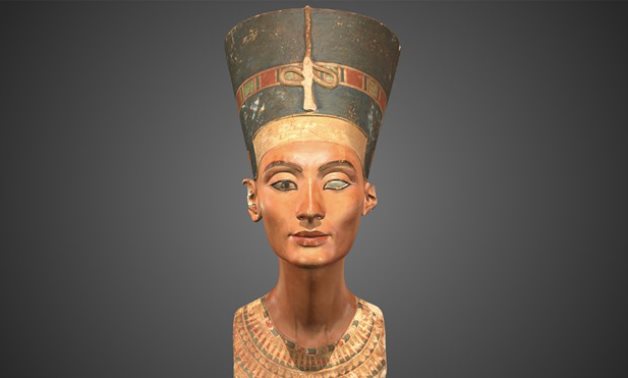
FILE - Ancient Egyptian Queen Nefertiti
CAIRO – 13 July 2020: British newspaper The Observer has highlighted new information that may lead to the location of the cemetery of Cleopatra, the legendary queen of ancient Egypt immortalized as a strong and beautiful historical figure.
Despite her fame, her burial place remains one of the unresolved mysteries. The tomb of the Ptolemaic Queen remains one of the lost ancient tombs believed to be in Egypt; it is also believed that many Pharaonic and Ptolemaic tombs have not yet been discovered.
Egyptian archaeologist Zahi Hawass had previously confirmed that most of the tombs of the Eighteenth Dynasty were missing and their exact locations have not been clarified to date.
Below is a list of the ancient cemeteries that are still being searched for:
Thutmose II
Thutmose II is the Fourth Pharaoh of the Eighteenth Dynasty of Ancient Egypt. He is the brother and husband of the great ancient Egyptian Queen Hatshepsut. Thutmose II is one of these pharaohs whose tomb has not yet been found. A large research team, led by Egyptian archaeologist Zahi Hawass, is searching for his tomb.
 Thutmose II
Thutmose II
According to Hawass, it is attributed to Thutmose II that he broke up a sit-in in Nubia. It was previously believed that he was buried in Cemetery No. 42, which is devoid of decorations and contains a sarcophagus. However, this belief was dismissed as his burial location has not been discovered yet.
Nefertiti
Nefertiti is the great queen of ancient Egypt and wife of Akhenaten, one of the greatest kings of the Eighteenth Dynasty. Nefertiti is one of the most powerful women of human history throughout the ages. To this day, her place of burial is unknown.
 Nefertiti
Nefertiti
Akhenaten's wife had disappeared in her final days. She is believed to have been buried in what is known today as Tel el-Amarna in Minya.
Archaeologist Nicholas Reeves of the University of Arizona is leading a research team to find the tomb of the Queen of Egypt, Nefertiti. It is believed that she is buried near the tomb of her son, the Golden Pharaoh, Tutankhamun.
Ankhesenamun is among the beautiful queens of the Amarna Era who are famous and influential in the history of ancient Egypt. She is the wife of the legendary golden king Tutankhamun. She is also the daughter of the great king Akhenaten and Queen Nefertiti.
 Ankhesenamun
Ankhesenamun
Her burial location is yet to be disclosed. Many believe she may have been buried in Cemetery 63 in the Valley of the Kings next to Tutankhamun's tomb. Numerous DNA tests have been carried out to determine Ankhesenamun’s mummy, which might be one of the two royal mummies of the Eighteenth Dynasty's queens discovered in Cemetery No. 21 of the Tombs of the Valley of the Kings. She may be the mummy labelled as KV21A. This is if the mummy discovered in the tomb of King No. 55 in the Valley of the Kings is discarded.
Ramses VIII
Ramses VIII is the seventh pharaoh of the Twentieth Dynasty and the last son of Ramses III. He held the throne of Egypt for almost one year between 1130 BC. And 1129 BC. He is the only king of the Twentieth Dynasty - normally buried in the Valley of the Kings- who’s burial location has never been identified.
 RamsesVIII
RamsesVIII
Some scholars have suggested that tomb 19 belonging to Prince Mentuherkhepse
was essentially the private tomb of Ramesses VIII, who ceded it after he ascended the throne of Egypt.
An Egyptian research team, led by Afifi Rahim and supervised by Zahi Hawass, is currently searching for Ramses VIII cemetery in the Valley of the Kings.
Alexander III of Macedon, is one of the legends of ancient history, and one of the greatest kings and leaders of the world throughout the ages. His tomb is one of the biggest mysteries to date. Many have conflicting opinions on the burial site that contains the remains of the founder of Alexandria. There are those who believe that he is outside Egypt, particularly in Aegean, Greece.
 Alexander The Great
Alexander The Great
Some scholars believe Alexander the Great is buried in Siwa Oasis in Egypt. According to the historian Pausanias, Ptolemy initially buried Alexander's body in Memphis. With the end of the fourth century B.C. or the beginning of the third century B.C., at the beginning of the Ptolemaic era, Alexander's body was moved from Memphis to Alexandria where he was reburied. Until this day, his exact burial location remains unknown.
Many research teams are still searching for Alexander the Great's cemetery and mummy, and many archaeologists are hoping they will be the first to find the mummy of the great Macedonian conqueror.





Comments
Leave a Comment